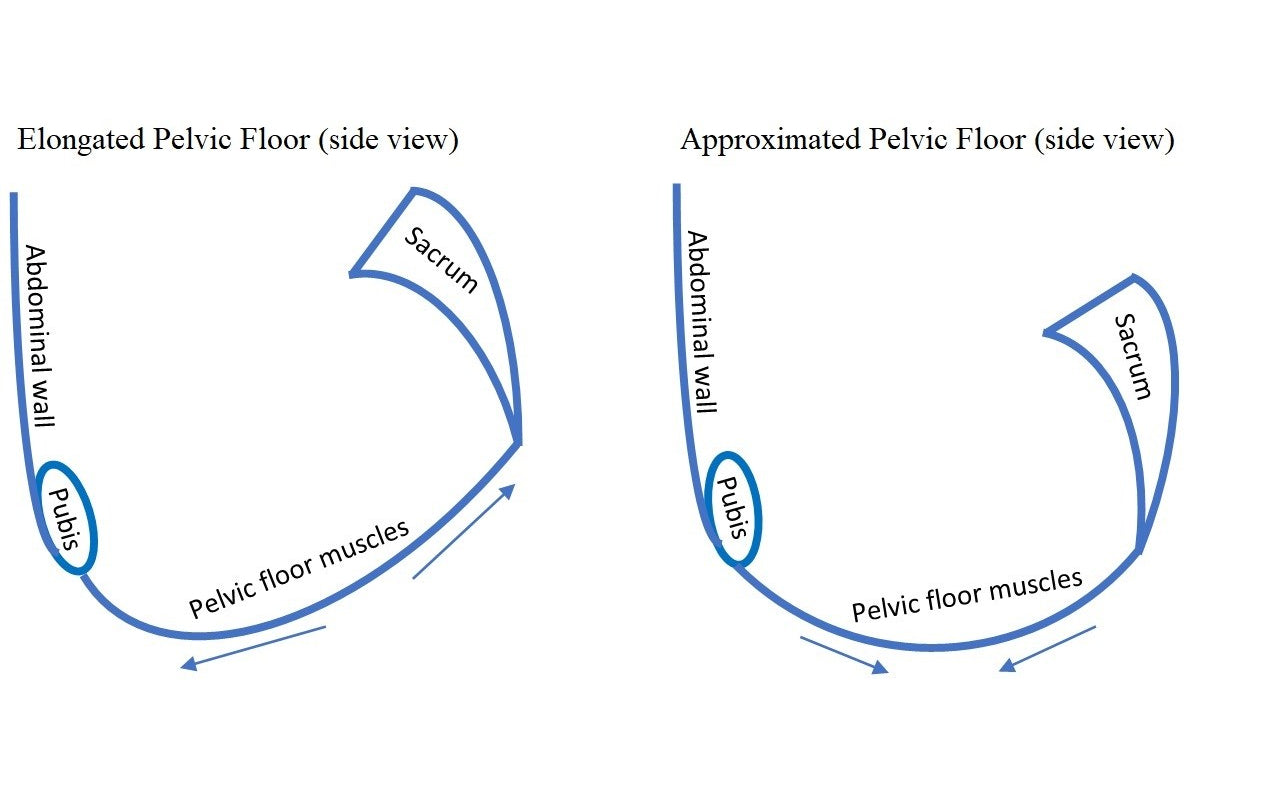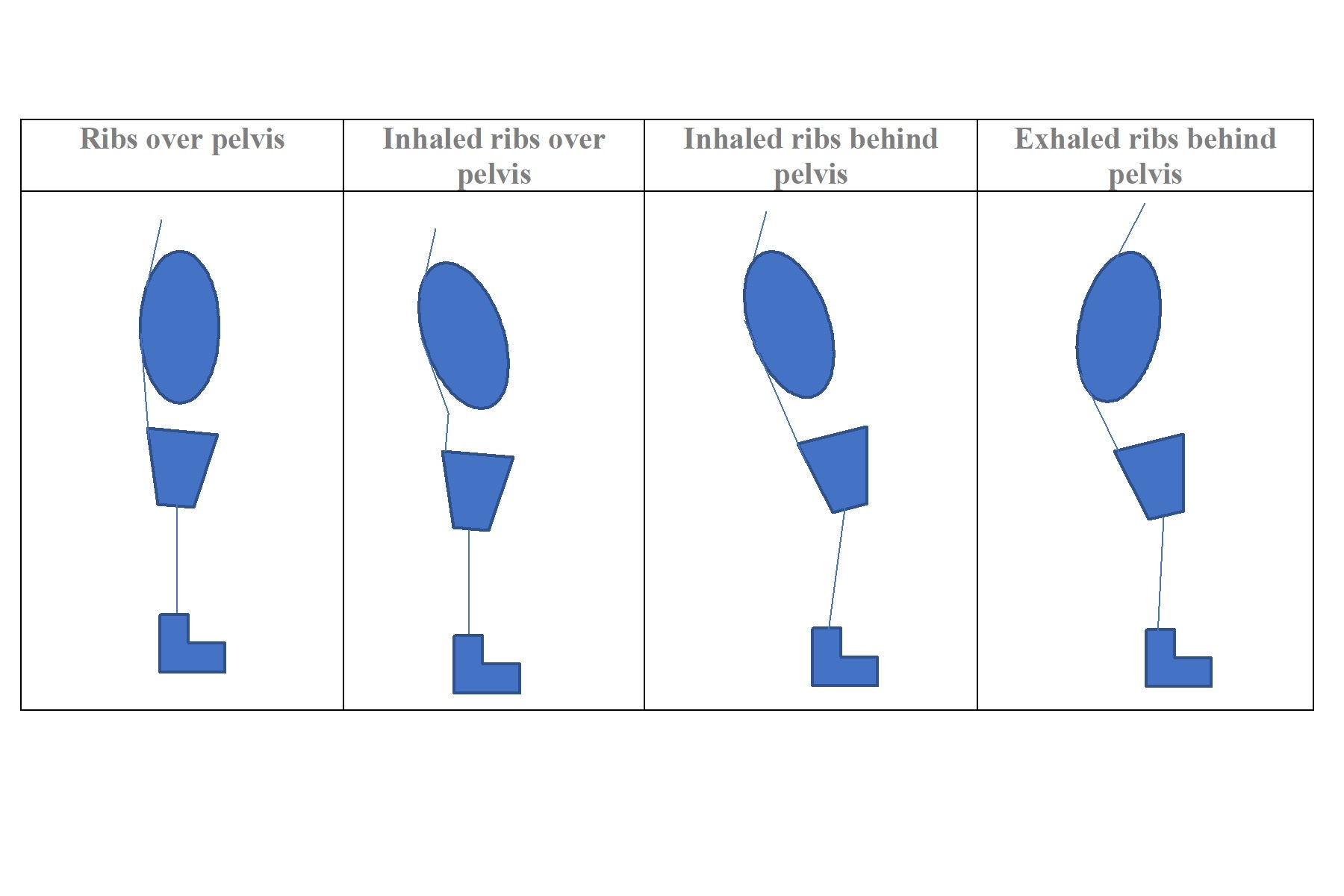Joanna Hess PT, DPT, PRC, WCS Wait! Marie Kondo has you throwing out your favorite jeans because the joyless saggy bottoms that your tushy cannot manage to fill out? We are seeing an epidemic flat butt among mamas, plumbers, barre fanatics, and office workers—all with strangely similar symptoms—pelvic floor dysfunction, low back and sacroiliac pain, and a tucked under pelvis. In this blog we will explore why the position of the pelvis, the maker of flat butts and the maker of less flat booties, is important and how to more easily move out of this position for benefit beyond your behind. Besides needing a new wardrobe, why should I care about my flat bum? The flat bum or preference towards posterior pelvic tilting shrinks the distance between the front and back of pelvic outlet which changes pelvic floor muscle tension. The body needs access to the full range of the pelvis and pelvic floor muscles. Over time, this position could cause excessive pelvic floor activity to compensate for the loss of resting tension. Think of the pelvic floor muscles simplified as a rubber band between two points, the pubic bone and tailbone. When the distance between the two points decreases, the rubber band loses its stability from resting tension. Changes in pelvic position alters stability from the pelvic floor muscles. This posterior pelvic tilt position also decreases the accessibility for hip extension and therefore the upper glute muscles get sleepy. As the top of the pelvis moves back, the sacroiliac joint in the low back opens and decreases its bony stability. Translated into everyday life, the flat butt position increases the potential for incontinence, pelvic floor muscle tension, sacroiliac pain, and decreased efficiency in movement. The Flat Bottom. Only in the eye of the beholder?

The disagreement of the “neutral pelvis” or zero-point causes confusion when describing pelvic tilt—anterior pelvic tilt, posterior pelvic tilt, and neutral pelvis. Some argue that the neutral pelvis is when the ASIS’s (front hip bones) are level to the PSIS (back butt dimples). Others say that the pelvis is neutral when ASIS’s are in the same plane as the pubic bone. Or for those with X-ray vision, pelvic tilt is the vector of the sacral angle at S2 in relation to the vertical axis. But often, neutral pelvic position is subjective to the observer and relative to other parts of the body—namely the spine/rib cage and thigh bone. Clinically, this “neutral pelvis” is hard to find because 1) pelvis’ are shaped very differently, 2) left and right pelvis on the same person can also be quite different, 3) feeling these bony landmarks have been shown to be remarkably unreliable, 4) the neutral pelvis should be on top of vertical thigh bones. See how the eyes can be tricked confusing spinal curve focusing on pelvic tilt without also including rib position.  The inability to move in and out of posterior pelvic tilt and anterior pelvic tilt decreases efficiency and possibly results in pain and instability. Anterior pelvic tilt is when the front part of the pelvis moves forward/down. Posterior pelvic tilt is when the front part of the pelvis moves back/up. A neutral pelvis on top of vertical femurs and happy rib cage should correlate with better muscle performance. Do I have a flat butt? Aside from the saggy jeans, the flat butts of the world have a few other correlations. 1. The Tailfeather Test: Stand comfortably and squeeze the gluts. a. Neutral pelvis: Thigh bones rotate. b. Posterior tilt-ing pelvis: The butt will further tuck under and mainly access the lower glutes. c. Anterior tilt-ing pelvis: The pelvic floor muscles will do most of the work. 2. You bear weight more in the heels 3. Back of your rib cage is behind your pelvis 4. Your Thigh bones are angled so that your pelvis is front of your knees 5. Your lower belly pooch 6. You Sit with pressure more on the sacrum/tailbone vs. sit bone 7. You have Overactive and possibly overworking pelvic floor muscles—the front to back pelvic distance decreases with your posterior tilted pelvis and loses the resting tension from length. As described earlier, this is similar to tensile strength of a slightly stretched rubber band vs. rubber band without pull/tension. Therefore, your pelvic floor muscles have to work harder to keep some type of tension for purposes like continence, stability, etc. The inability for the pelvic floor muscles to work optimally can lead to incontinence, pain, and constipation. 9. You have Breathing and abdominal pressure problems 10. You have Sacroiliac joint pain. As the pelvis tips back, the sacrum moves away from the ilium decreasing the bony stability. The hip muscles have to work harder, but as felt in the Tailfeather Test, the glut muscles aren’t in a good place to work. Is there a better fix than butt implants? Bodies have and love variability for posterior, anterior and “neutral” pelvic positioning. The brain likes positions where muscles and nerves work with ease and stability—life shouldn’t be so difficult—but it needs the chance to choose and learn it. Folks working with bodies have traditionally “corrected” spinal curves by changing pelvic position. From what has already been discussed, spinal and pelvic position can be altered many different ways—from the changing weight-bearing area in the feet, to position of ribs and range of breath, and even head angles with visual and vestibular input. Consider these hacks into pelvic stability until the brain learns how to access this stability in many situations and positions. 1. Standing. Bring your chin down to your neck and keep looking down until you see the front of your ankles. You’ve just untucked your pelvis and brought your ribs over your pelvis. This one is courtesy of my colleague, Stephanie Stamas. Or check in to feel where the weight is going through your feet. The front to middle of the foot is a good place to start and then do the Tailfeather Test. You might have to toggle other parts of the body because of how the body will compensate in the chain. 2. Sitting. Get your hips as far back as possible. Or put a pillow in the back of the chair so that your hips can find the pillow and you are sitting on top of your sit bones. Then, relax the trunk into the seat back/pillow. Again, you’ve untucked your pelvis and brought your ribs over the pelvis. 3. Better squats/lunges/burpees/stairs/ab work. You can do 5 sets of 20 squats, but still no junk? Take care to see if your pelvis is tucking under in the movement. If so, use an inhale to keep the pelvic floor lengthening as your hips bend in movement. Later, the movement should be dissociated with breath pattern (as long as you are breathing.) 4. See a physical therapist. Often times, the habits of pelvic tucking are a little more complicated because it is a protective and compensatory mechanism for stability. A physical therapist can help with seeing the bigger picture and how different parts of the body relate to each other. They can also help facilitate better movement through manual therapy and specialized movement. Good luck with the joy sparking!
The inability to move in and out of posterior pelvic tilt and anterior pelvic tilt decreases efficiency and possibly results in pain and instability. Anterior pelvic tilt is when the front part of the pelvis moves forward/down. Posterior pelvic tilt is when the front part of the pelvis moves back/up. A neutral pelvis on top of vertical femurs and happy rib cage should correlate with better muscle performance. Do I have a flat butt? Aside from the saggy jeans, the flat butts of the world have a few other correlations. 1. The Tailfeather Test: Stand comfortably and squeeze the gluts. a. Neutral pelvis: Thigh bones rotate. b. Posterior tilt-ing pelvis: The butt will further tuck under and mainly access the lower glutes. c. Anterior tilt-ing pelvis: The pelvic floor muscles will do most of the work. 2. You bear weight more in the heels 3. Back of your rib cage is behind your pelvis 4. Your Thigh bones are angled so that your pelvis is front of your knees 5. Your lower belly pooch 6. You Sit with pressure more on the sacrum/tailbone vs. sit bone 7. You have Overactive and possibly overworking pelvic floor muscles—the front to back pelvic distance decreases with your posterior tilted pelvis and loses the resting tension from length. As described earlier, this is similar to tensile strength of a slightly stretched rubber band vs. rubber band without pull/tension. Therefore, your pelvic floor muscles have to work harder to keep some type of tension for purposes like continence, stability, etc. The inability for the pelvic floor muscles to work optimally can lead to incontinence, pain, and constipation. 9. You have Breathing and abdominal pressure problems 10. You have Sacroiliac joint pain. As the pelvis tips back, the sacrum moves away from the ilium decreasing the bony stability. The hip muscles have to work harder, but as felt in the Tailfeather Test, the glut muscles aren’t in a good place to work. Is there a better fix than butt implants? Bodies have and love variability for posterior, anterior and “neutral” pelvic positioning. The brain likes positions where muscles and nerves work with ease and stability—life shouldn’t be so difficult—but it needs the chance to choose and learn it. Folks working with bodies have traditionally “corrected” spinal curves by changing pelvic position. From what has already been discussed, spinal and pelvic position can be altered many different ways—from the changing weight-bearing area in the feet, to position of ribs and range of breath, and even head angles with visual and vestibular input. Consider these hacks into pelvic stability until the brain learns how to access this stability in many situations and positions. 1. Standing. Bring your chin down to your neck and keep looking down until you see the front of your ankles. You’ve just untucked your pelvis and brought your ribs over your pelvis. This one is courtesy of my colleague, Stephanie Stamas. Or check in to feel where the weight is going through your feet. The front to middle of the foot is a good place to start and then do the Tailfeather Test. You might have to toggle other parts of the body because of how the body will compensate in the chain. 2. Sitting. Get your hips as far back as possible. Or put a pillow in the back of the chair so that your hips can find the pillow and you are sitting on top of your sit bones. Then, relax the trunk into the seat back/pillow. Again, you’ve untucked your pelvis and brought your ribs over the pelvis. 3. Better squats/lunges/burpees/stairs/ab work. You can do 5 sets of 20 squats, but still no junk? Take care to see if your pelvis is tucking under in the movement. If so, use an inhale to keep the pelvic floor lengthening as your hips bend in movement. Later, the movement should be dissociated with breath pattern (as long as you are breathing.) 4. See a physical therapist. Often times, the habits of pelvic tucking are a little more complicated because it is a protective and compensatory mechanism for stability. A physical therapist can help with seeing the bigger picture and how different parts of the body relate to each other. They can also help facilitate better movement through manual therapy and specialized movement. Good luck with the joy sparking!




